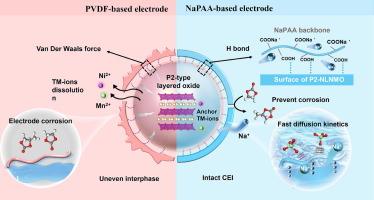通过环保型水性粘合剂加强层状氧化物阴极的敏感界面
IF 14.9
1区 化学
Q1 Energy
引用次数: 0
摘要
层状氧化物作为钠离子电池(sib)的正极材料具有巨大的潜力。然而,界面不稳定性和反应动力学缓慢等挑战严重限制了它们的速率能力和循环性能。在这里,我们介绍了水溶性聚丙烯酸钠(NaPAA)粘合剂作为一种有前途的方法来减轻这些问题在p2型层状氧化物。NaPAA粘结剂有利于形成均匀的Na+导电界面膜,保护阴极免受电解腐蚀,并有效抑制过渡金属在P2-Na0.85Li0.12Ni0.22Mn0.66O2 (NLNMO)中的溶解。此外,我们还阐明了NaPAA结合剂动态调节电极-电解质界面上自由阴离子配位的机制。这种调节减少了溶剂的分解,促进了稳定的离子导电层的形成。因此,P2-NLNMO@NaPAA集成电极表现出增强的电化学性能,在0.2℃下循环200次后,容量保持率达到89.2%,即使在0℃下也能提供102.9 mA h g−1的初始容量。本研究促进了对粘合剂介导的界面工程的基本理解,并展示了高性能sib的可扩展和环保制造途径。本文章由计算机程序翻译,如有差异,请以英文原文为准。

Strengthening the susceptible interphase of layered oxide cathodes via eco-friendly aqueous binders
Layered oxides present compelling potential as cathode materials for sodium-ion batteries (SIBs). However, challenges including interfacial instability and sluggish reaction kinetics critically limit their rate capability and cycling performance. Herein, we introduce the water-soluble sodium polyacrylate (NaPAA) binder as a promising approach to mitigating these issues in P2-type layered oxides. The NaPAA binder facilitates the formation of a uniform Na+ conductive interfacial film, which protects the cathode against electrolyte-induced corrosion and effectively inhibits the dissolution of transition metals in P2-Na0.85Li0.12Ni0.22Mn0.66O2 (NLNMO). Furthermore, we elucidate the mechanism by which the NaPAA binder dynamically regulates the coordination of free anions at the electrode–electrolyte interface. This regulation reduces solvent decomposition and promotes the formation of a stable, ionically conductive layer. Consequently, the P2-NLNMO@NaPAA integrated electrode exhibits enhanced electrochemical performance, achieving an 89.2 % capacity retention after 200 cycles at 0.2 C and delivering an initial capacity of 102.9 mA h g−1 even at 0 °C. This study advances the fundamental understanding of binder-mediated interface engineering and demonstrates a scalable and eco-friendly manufacturing pathway for high-performance SIBs.
求助全文
通过发布文献求助,成功后即可免费获取论文全文。
去求助
来源期刊

Journal of Energy Chemistry
CHEMISTRY, APPLIED-CHEMISTRY, PHYSICAL
CiteScore
19.10
自引率
8.40%
发文量
3631
审稿时长
15 days
期刊介绍:
The Journal of Energy Chemistry, the official publication of Science Press and the Dalian Institute of Chemical Physics, Chinese Academy of Sciences, serves as a platform for reporting creative research and innovative applications in energy chemistry. It mainly reports on creative researches and innovative applications of chemical conversions of fossil energy, carbon dioxide, electrochemical energy and hydrogen energy, as well as the conversions of biomass and solar energy related with chemical issues to promote academic exchanges in the field of energy chemistry and to accelerate the exploration, research and development of energy science and technologies.
This journal focuses on original research papers covering various topics within energy chemistry worldwide, including:
Optimized utilization of fossil energy
Hydrogen energy
Conversion and storage of electrochemical energy
Capture, storage, and chemical conversion of carbon dioxide
Materials and nanotechnologies for energy conversion and storage
Chemistry in biomass conversion
Chemistry in the utilization of solar energy
 求助内容:
求助内容: 应助结果提醒方式:
应助结果提醒方式:


